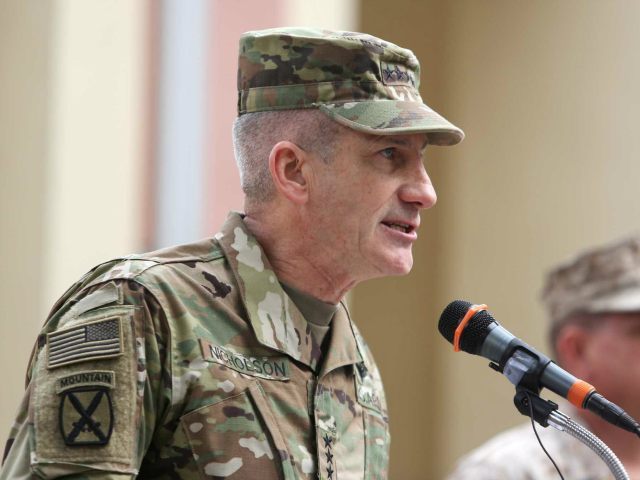U.S. Army Gen. John W. “Mick” Nicholson has assumed command of American and NATO forces in Afghanistan in the midst of a vicious Taliban resurgence and a growing Islamic State (ISIS/ISIL) presence.
On Wednesday, Gen. Nicholson took over from U.S. Army Gen. John Campbell, who served as the top commander in Afghanistan when the international combat mission there was declared over at the end of 2014.
Campbell also oversaw an escalation of Taliban-perpetrated violence and ISIS’s expansion into the Afghanistan-Pakistan region in January 2015. The ISIS Afghan-Pakistan branch is known as the Khorasan Province (ISIL). It has been officially designated a terrorist organization by the U.S. government.
“In a ceremony at the headquarters of the U.S.-NATO Resolute Support mission in Kabul, Nicholson thanked NATO representatives for standing by the U.S. after the September 11, 2001, attacks on ‘the homeland,’” reports the Associated Press (AP).
“I know you,” he added, addressing the Taliban. “You have brought only hardship and suffering to the Afghan people.”
Afghan security forces and civilians have suffered record casualties since President Obama and NATO declared an end to their combat mission and reduced their military footprint in the country to around 13,000 international troops, including 9,800 Americans, according to the Pentagon.
When the president ended the combat mission, he took away the U.S. military’s authority to offensively attack the Taliban.
“I have the authority to protect our coalition members against any insurgency — Haqqani [Network], Taliban, al Qaeda — if they’re posing as a threat to our coalition forces,” Campbell told a House panel in early February, later adding, “To attack the Taliban just because they’re Taliban, I do not have that authority.”
The Taliban’s reach in Afghanistan is reportedly greater than at any point since the terrorist group was removed from power following the U.S.-led invasion in 2001.
Meanwhile, a growing ISIL-K has established a stronghold in Afghanistan’s Nangarhar province, which borders Pakistan.
In September 2015, the United Nations reported that ISIL-K was actively recruiting in 75 percent (25) of Afghanistan’s 34 provinces.
Gen. Campbell has estimated that there are up to 3,000 ISIS loyalist in Afghanistan. In January, the White House granted the Pentagon legal authority to take offensive action against the Khorasan Province.
“We currently characterize them as operationally emergent,” U.S. Brig. Gen. Wilson Shoffner, a top spokesman for the U.S.-led NATO coalition in Afghanistan, told reporters in January, referring to ISIL-K.
During the same month, Pentagon Press Secretary Peter Cook also told reporters that the Obama administration believes it is “on the right course” in Afghanistan.
The Taliban and ISIL-K are fighting each other for territory and influence in Afghanistan.
Nicholson has deployed to Afghanistan three times between 2006 and 2012.

COMMENTS
Please let us know if you're having issues with commenting.